Ryugu may have originated from a comet nucleus that contained amino acids needed for life on Earth
June 13, 2022 (JST)
Japan Aerospace Exploration Agency (JAXA)
Sample analysis of material returned from asteroid Ryugu through the efforts of the Hayabusa2 Project Team are being carried out by the Hayabusa2 Initial Analysis Team, which consists of 6 sub-teams, and two Phase-2 curation institutions, Okayama University and the Japan Agency for Marine-Earth Science and Technology (JAMSTEC) Kochi Institute for Core Sample Research. This paper summarises research results from the Okayama University Phase-2 curation that was published in the Proceedings of the Japan Academy on June 10, 2022.
Initial Analysis of the Asteroid Ryugu Sample
After the asteroid exploration mission, Hayabusa2, returned a sample of material from asteroid Ryugu to the Earth, an initial description of the sample was conducted at the curation facility established at the JAXA’s Institute of Space and Astronautical Science. Part of the sample was then distributed to the Hayabusa2 Initial Analysis Team, consisting of six sub-teams, and two Phase-2 curation institutes at Okayama University and the JAMSTEC Kochi Institute for Core Sample Research. The role of the Initial Analysis Team is to reveal the multifaceted features of the sample through planned high-precision analysis, with specialized sub-teams assigned to tackle the scientific objectives for the Hayabusa2 mission. The Phase-2 curation institutes apply their expertise to cataloguing the sample based on a comprehensive analytical pipeline in order to clarify the potential value of the sample through measurements and analysis appropriate to the sample characteristics.
Reports from the six teams and from the JAMSTEC Kochi Institute for Core Sample Research will be announced separately after journal publication. Once all the initial results have been released, a new overall summary of the Hayabusa2 science is planned.
Origin and Evolution of Asteroid Ryugu
- A comprehensive geochemical analysis of the evolution of material in the Solar System -
Nakamura Eizo, Okayama University
Research Summary
A detailed comprehensive geochemical analysis was performed on 16 grains recovered from asteroid Ryugu, the target of the Japanese asteroid explorer Hayabusa2 mission. The results revealed that the asteroidal material sample retains evidence of complex physico-chemical processes that occurred from before the formation of the Solar System through to the present, providing a new picture of the evolution of material in the Solar System, including that of the origin of life.
Research highlights
- For the first time, a comprehensive geochemical analysis has been carried out on the sample returned from the C-type asteroid Ryugu, which was believed to contain a substantial quantity of organic matter.
- The sample is the least contaminated asteroid material on Earth. It was recovered from two sites on asteroid Ryugu, and has been analysed from a geological perspective.
- The sample is mainly composed of hydrous phyllosilicate minerals, with a porosity of approximately 50%.
- The chemical composition of the asteroid is similar to that of CI chondrites. It has also been confirmed that the sample contains material collected not only from the surface of Ryugu, but also from the interior material that was ejected as a result of the formation of the artificial crater.
- Contamination from the tantalum projectiles used during the sampling was seen in part of the sample, but no contamination from the copper impactor (SCI: Small Carry-on Impactor) that was used to create the artificial crater was observed.
- Micron-sized organic material originating from interstellar clouds showing hydrogen, carbon and nitrogen isotopic anomalies was detected.
- Amino acids and other organic matter associated with the origin of life were detected.
- Primordial features were retained in the sample, including from the interstellar material and precursors to the Solar System that formed the primordial Solar System.
- The precursor body of the asteroid Ryugu is an icy body (ice precursor) in which ice-rich dust containing organic matter and silicates accumulated in the outer Solar System.
- The ice precursor was several tens of kilometers in size and experienced aqueous alteration during a period up to about 2.6 million years after the formation of the Solar System.
- The ice precursor fragmented and formed a comet nucleus of about several kilometres in size. This celestial body then moved into a near-Earth orbit. Sublimation of the comet nucleus ice, reduction of the body size and redisposition of material from gas, resulted in the formation of a low-density material with many voids.
- Organic material is ubiquitous in the sample, and has been subjected to space weathering from cosmic rays and solar wind irradiation, which determines the albedo (reflective) properties of the asteroid surface.
Background
Asteroid Ryugu was the target destination of the Hayabusa2 asteroid exploration mission. Ryugu is a C-type asteroid, which is a more primitive type than asteroid Itokawa (S-type) from which the first Hayabusa mission successfully collected and returned the first asteroid sample in 2010. C-type asteroids are thought to be rich in organic matter and water. The Hayabusa2 spacecraft performed a detailed geophysical survey of asteroid Ryugu, and collected surface material from two sites (total weight of about 5.4g) and returned these to Earth. With minimal contamination from the Earth’s environment, the detailed analysis of this sample was expected to provide new insights into the formation and evolutionary processes of organic matter and water, which are closely related to the origin of life, in addition to that of primitive inorganic materials. Additionally, a deeper understanding of the formation process of asteroids would inevitably be a major step in understanding both the origin of materials that make up our own Solar System, and the dynamics of material evolution over the approximately 4.56 billion years since their formation to the present. As a higher-order curation organisation (P2C-PML: Phase-2 curation-PML) from the collaboration between JAXA’s Institute of Space and Astronautical Science and Okayama University, we took on this first-class research challenge to conduct a comprehensive analysis suing the Comprehensive Analysis System for Terrestrial and Extra-terrestrial Materials (CASTEM).
Research details
This study performed a comprehensive geochemical analysis on 16 grains from the sample collected by the Hayabusa2 spacecraft from vicinity of the surface layer at two touchdown sites (hereafter, TD1 and TD2) on the C-type asteroid Ryugu (TD1: 7 grains, TD2: 9 grains, total 55mg). In comparison, only a small sample (6 grains of several tens of microns in size, about 2µg in total) from the S-type asteroid Itokawa returned by Hayabusa was analysed using CASTEM. For the Itokawa sample, we specialised in a microbeam analysis to estimate the surface environment of ultra-microgravity bodies exposed to space as recorded by the grain surfaces (Nakamura et al., 2012). The total amount of 55mg of Ryugu sample that could be used in this analysis is about 30,000 times the total amount of the Itokawa sample. Through making use of this volume of sample, and practicing comprehensive material science, we were able to tackle research aimed at understanding the origin of asteroids, the structure of celestial bodies, and the physio-chemical processes related to material evolution and transitions that was difficult with the analysis of the Itokawa sample.
After being recovered from the asteroid surface, the Ryugu grains were delivered to the P2C-PML without any direct contact with the Earth’s environment (Figure 1). This minimised any effects of contamination caused by the Earth’s environment, which is an issue with meteoritic materials. The ability to directly interpret the results obtained as characteristics of extra-terrestrial material is a great advantage. The analysis confirmed that the Ryugu material constitutes 0.69 – 1.30 wt% hydrogen (mainly in the hydrous mineral phase) and 2.79 – 5.39 wt% carbon (of which 1.77 – 4.00 wt% is organic matter), both of which are essential for the formation of life. Many organic compounds were also detected, including amino acids and nitrogen-containing heterocyclic compounds. There was one type of amino acid that has been detected in meteorites, but was not found in the Ryugu sample. The fact that the Ryugu sample is free of contamination from Earth means that the 23 types of amino acids detected (including isomers) must have originally existed in the Solar System other than on the Earth. We therefore conclude that organic matter, including amino acids, may have formed and evolved on icy bodies, and that life may have originated from the introduction of this organic matter into the Earth’s environment. Future research will clarify the details about this relationship to the origin of life.
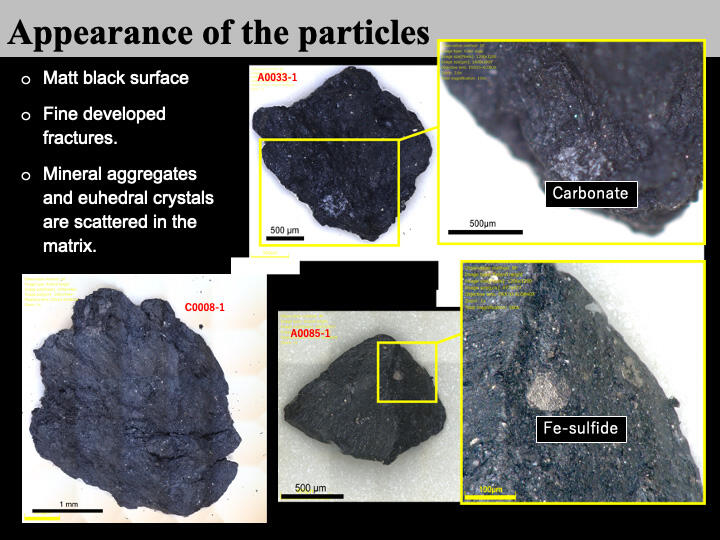
(c) Nakamura et al. (2022)
Figure 1: Appearance of Ryugu grains. The grains have black matte surface with fine fractures (left). Mineral aggregates and euhedral crystals are scattered through a fine-grained dense matrix (right).
A high-precision chemical analysis was performed on all 16 grains to determine concentrations of up to 70 elements per particle. The results revealed that the chemical characteristics of Ryugu are similar to that of CI chondrites. Detailed petrographic descriptions of all the grains indicate that the Ryugu material is comprised of a fine-grained matrix consisting of fine hydrous phyllosilicates minerals (50 vol%) and voids (41 vol%), and a coarse-grained phase (9%) consisting of inorganic minerals and organic matter with a density of about 1.52 g/cm3. While high-temperature formations (e.g., those that have experienced melting) formed within the Solar System nebula are universally observed in meteorites classified as CI chondrites, few of these high-temperature formations are contained in the Ryugu sample. This suggests that the Ryugu material accumulated in low-temperature regions relatively far from the Solar System, and has retained these primordial properties to the present day.
The concentration and isotopic composition of elements (H, Be, B, N, Ca, and Cr) in the grains was analysed, as well as the micron-sized organic matter exhibiting characteristic isotopic compositions (H, C, and N). The results identified organic and inorganic material of different origin in the Ryugu sample, including interstellar material out of which the Solar System was formed, and material from prior to the Solar System’s formation. Furthermore, high precision measurements of the oxygen, calcium, and chromium isotopic compositions indicate that the asteroid Ryugu is the most primitive of Solar System material since the effect of homogenization in the early Solar System nebula is much smaller than that experienced by other extra-terrestrial samples (meteorites). The neon isotope signature also suggests the Solar System environment should have been exposed to high-energy particle irradiation prior to, or shortly after, the formation of the Solar System (approximately 4.6 billion years ago). As neon isotopic composition is traditionally used to estimate the exposure age of extra-terrestrial samples, this discovery that neon isotopic composition could be significantly altered during Solar System formation means that such assumptions need to be re-examined.
Since the present Ryugu sample is composed mainly of hydrous minerals, the reaction between amorphous silicates and liquids mainly comprised of water (i.e. aqueous alteration) is thought to have played an important role in the evolution of the material. Mn-Cr dating was applied to carbonates thought to have crystallised from liquids during aqueous alteration, and oxygen isotope thermometry was applied to the carbonates and the coexisting magnetites. These results showed that carbonate minerals formed about 2.6 million years after the formation of the Solar System (4.5647 billion years ago), at temperatures ranging from 0 to 30°C. For these conditions to exist, it is natural to suppose that the precursor to Ryugu was an icy body that accumulated organic matter and ice-rich dust containing silicates shortly after the formation of the Solar System. From thermodynamic calculations, the size of the parent icy body is estimated to be several tens of kilometres, and its solid-liquid boundary layer is thought to be the formation site of the Ryugu sample. The formation region for such icy bodies must be outside the snowline (outer Solar System), where ice-rich dust can exist, and the aforementioned chemical evidence indicates that homogenisation of materials has not yet occurred. A theoretical Solar System formation model incorporating this evidence from material science is expected to be developed.
Conditions estimated by the oxygen isotope thermometry indicate that the icy body was heated to melt the ice into liquid water and allow aqueous alteration. From chronological information on the occurrence of the aqueous alteration, 26Al is likely to be the heat source; a radioactive nuclide that was distributed throughout the celestial body (Figure 2). As a result of the melting of the icy body, water-based liquids were formed that could then react with inorganic material to form hydrous mineral phases, carbonates, magnetite, iron sulphides, and other constituent phases that are now observed in the Ryugu sample. The morphology and distribution of the polyhedral magnetite particles with uniform size (Figure 3) suggests the presence of water-soluble organic matter in the liquid, and that freezing and thawing cycles were repeated due to some environmental disturbance. During this process, the complex α- and β-amino acids and nitrogen-containing heterocyclic compounds that were detected in the Ryugu grains were synthesised from simple organic molecules originating from interstellar clouds and the primordial solar nebula.
As 26AI decreased over time and the heat generated by its radioactive decay likewise decreased, the interior of this icy body froze once more. The Nice Model and other models of the formation of our Solar System suggest that the formation of icy fragments of a few kilometers in size from collisions between celestial bodies resulting from the dynamics of the early Solar System led to the ancestors of the present-day Ryugu.
Asteroid Ryugu has long been thought to have a rubble-like structure formed by the collision and reaccumulation of celestial bodies. The asteroid’s characteristic spinning top shape is the result of deformation caused by rotation after the reaccumulation, and it has been thought that the present shape was reached as a result of changes to the rotation period caused by the YORP effect (from the scattering of solar radiation) and other factors. However, this model cannot answer questions such as how the original material of Ryugu formed and evolved, and where in the Solar System the impact fragmentation and reaccumulation occurred.
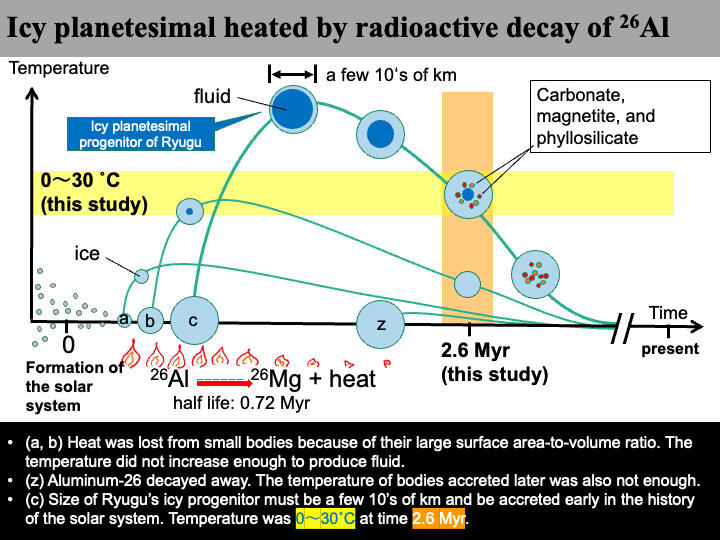
(c) Nakamura et al. (2022)
Figure 2: Thermal history of the ice precursor of asteroid Ryugu. The fact that the Ryugu sample is composed mainly of hydrous minerals indicates that the reaction of amorphous silicates with liquid played an important role in the evolution of the material. The timing and temperature of these reactions were estimated to be about 2.6 million years after the formation of the Solar System (4.5647 billion years ago), at a temperature between 0 and 30°C. These constraints allow a thermal history for the ice precursor to be inferred. The main source of heat for the body was energy released by the decay of the radionuclide 26AI that was incorporated during its formation. For a small body, the surface-to-volume ratio is large and radiative cooling cannot be ignored. Therefore in this case, the object would not be heated sufficiently to form a liquid, or if liquid is formed, then it cannot be retained until 2.6 million years after the formation of the Solar System (thermal history a, b). In addition, if the body is large but the timing of its formation is delayed, then the temperature will also not rise sufficiently due to the lower abundance of 26AI at this time (thermal history z). Based on thermodynamic calculations, the size of the icy precursor is estimated to be several tens of kilometers (thermal history c: Ryugu ice precursor). If an icy body of this size accumulates early after the formation of the Solar System, it can meet the required time constraints for aqueous alteration (carbonate and magnetite crystallization) and form sufficient liquid within its interior. The body then cools as 26AI is consumed and the solid-liquid boundary layer moves towards the body centre as a result of refreezing from the body surface inwards. This solid-liquid boundary is thought to have been the primary formation site of the Ryugu sample (see Figure 4 for details).
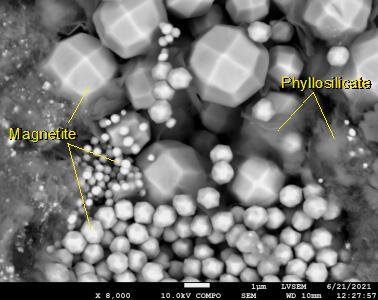
(c) Nakamura et al. (2022)
Figure 3: Scanning electron microscope image showing the occurrence of the polyhedral magnetite particles.
We propose a “comet nucleus” asteroid formation model in which icy body fragments several kilometers in size moved from the outer Solar System to the inner Solar System (near-Earth orbit), and the associated increase in solar radiation heat causes the loss of ice, leading to the present day Ryugu. Recently proposed physical models have shown that the gradual loss of ice from a comet nucleus through sublimation reduces the size of the body without dissipating momentum. As a result, the rotation velocity of the body increases, forming the spinning top shape that is characteristic of Ryugu (Miura et al., 2022). The ice sublimation process can explain the very porous microstructure of the Ryugu sample. The comet nucleus which was originally a mixture of fine inorganic / organic constituent phases and ice, lost its ice by sublimation, and the remaining inorganic / organic phases were loosely bonded to form the current voids. The void (ice) volume ratio of about 41% is constituent with the water/rock ratio estimated from thermodynamic calculations of the mineral phases.
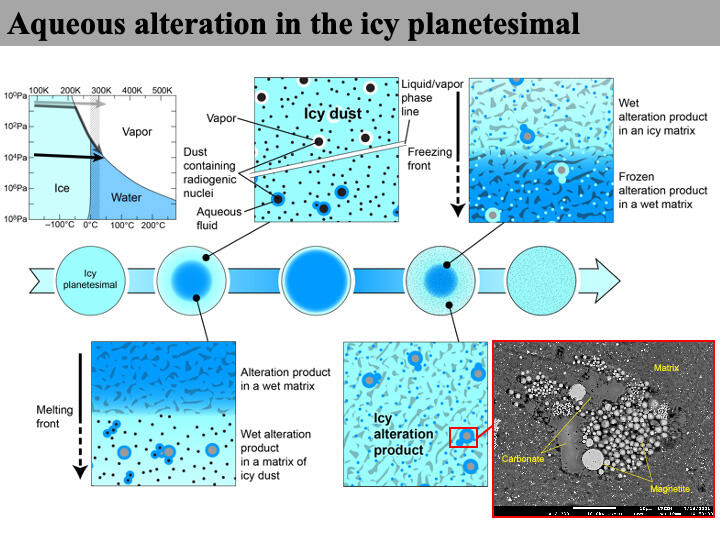
(c) Nakamura et al. (2022)
Figure 4: Aqueous alteration processes within the ice precursor. (Upper left) Heat from the decay of radionuclides causes a phase transition in the ice around the dust. Although sublimation occurs in the extremely low-pressure conditions near the surface, the ice melts and generates aqueous liquid at the internal pressures within the body. (Lower left) Silicate components and organic matter in the dust react with the aqueous liquid to transform into hydrous silicate minerals and other substances, causing extensive aqueous alteration from the interior to the surface of the body. (Upper right) When radioactive decay is complete, freezing progresses from the surface through the interior of the body. Due to differences in the freezing point and reaction rates caused by the diversity of chemical compositions of the aqueous liquids, and local stress changes caused by volume changes associated with freezing, a gradual transition zone consisting of two solid-liquid phases develops, and freezing and thawing repeated. (Lower right) In the droplets of aqueous liquid in which large quantities of mineral and organic components were dissolved, freeze-thaw cycles are repeated, isolated from the earlier frozen matrix, and the formation and growth of a variety of minerals takes place.
Also, as recent comet exploration had shown, ice sublimates not only from the surface of the comet nucleus, but also forms jets as gas intermittently erupts from the interior through cracks. The jet ejects not only gas but also internal solid material into space, some of which reaccumulates on the surface layer of the comet nucleus. This model can account for differences in geochemical features between the samples collected at TD1 and TD2. The TD2 sample, with its relatively uniform chemistry, was formed by the gradual sublimation of ice from the surface layer, while the TD1 sample, which shows variations in trace element concentrations, was formed when material transported by jets from within the comet nucleus mixed with surface material and re-solidified. This mixing is presumed to have caused the icy body from which the comet nucleus originated to become partially heterogeneous (Figure 5). Through this process, the present-day asteroid Ryugu was formed.
Non-isotropic material (chondrules, olivine of amoeboid olivine aggregate origin, and low-Ca pyroxene) observed in the Ryugu sample that have not undergone aqueous alteration in the icy body, or rock fragments with different isotopic characteristics, may have gathered and accumulated from outside the icy body at the same time as materials associated with the ice sublimation process re-accumulated. The comet nucleus is thought to have developed a rubble-like structure, one of the characteristics of the asteroid Ryugu, by causing part of the celestial body to collapse and fall inside a crack where jets were repeatedly ejected (Figure 5). The surface of the comet nucleus, which had now lost its ice, was exposed to the solar wind and cosmic rays, resulting in the alteration of organic matter near the surface layer and associated increase in albedo.
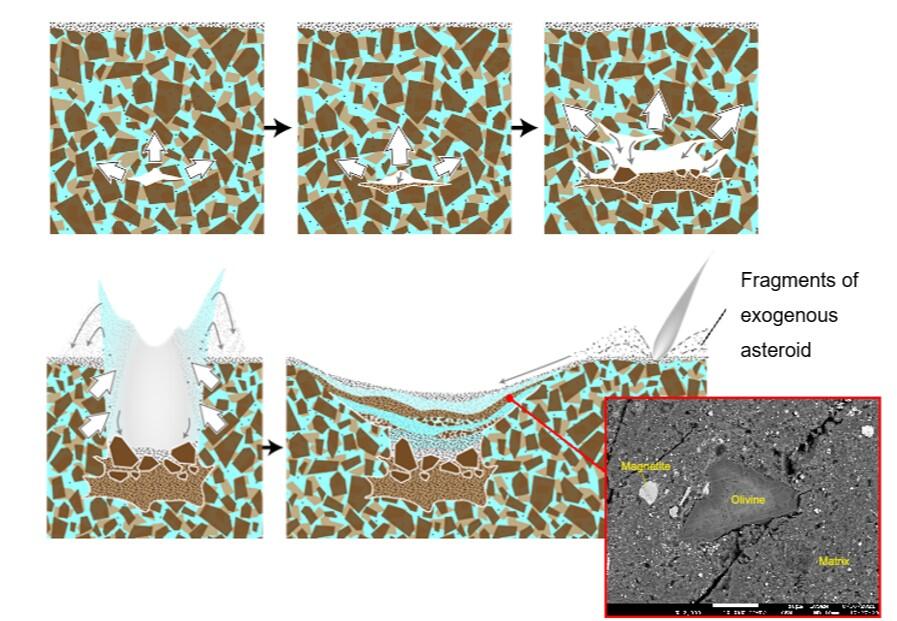
(c) Nakamura et al. (2022)
Figure 5. Dynamics of the surface layer of the comet nucleus due to sublimation. (Upper row) Ice sublimation caused by solar radiation creates cavities in the subsurface. The subsequent sublimation and pressure of the water vapour propagate the cracks and enlarge the cavity, which eventually causes the collapse of the ceiling area. (Lower row) When the ceiling collapses to form a mortar-shaped depression, sublimation of ice causes subsurface material (including ice) to erupt along with water vapour from the depression walls (Vincent et al., 2015). The falling debris, along with surface material including debris from non-homogenous sources, mixes with subsurface material including ice, before being redeposited and condensing under rock pressure to form an orderly layer. In this way, the structure of the comet nucleus surface layer is locally modified. (Figure text: fragments of exogenous asteroid.)
We believe that the present-day asteroid Ryugu was formed through the above processes (Figure 6). A series of comprehensive geochemical analyses have shown that the asteroid Ryugu sample may retain a variety of geophysical and chemical information from before the formation of the Solar System to the present. The confirmation of the presence of water and organic matter such as amino acids will allow for a deeper discussion of the relationship between asteroids, their ice precursors such as Ryugu, and life on Earth. We hope that the results of this research will encourage interdisciplinary discussion and collaboration and help us gain a better understanding of the Solar System and the worlds beyond.
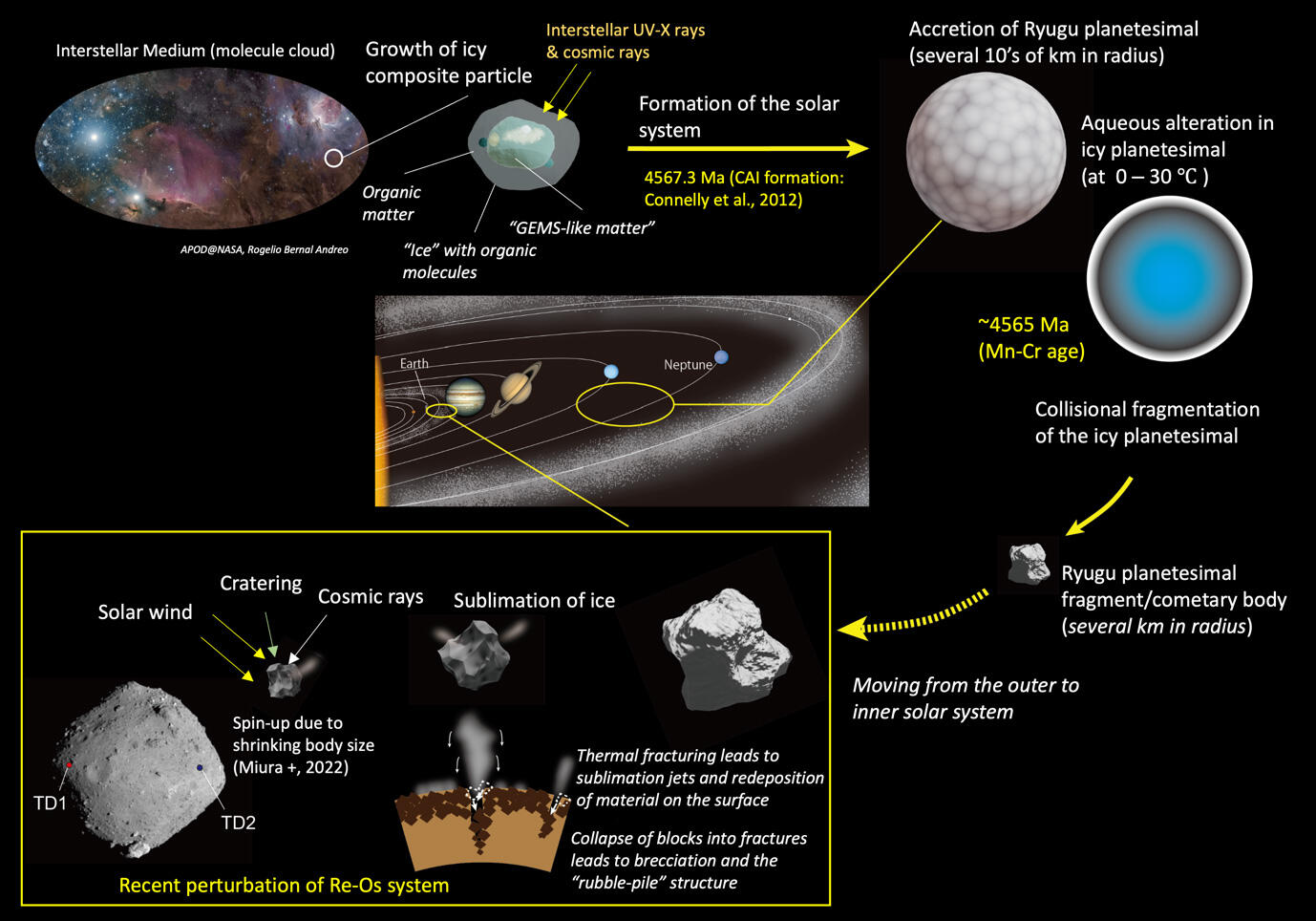
(c) Nakamura et al. (2022)
Figure 6: Origin and evolution of the asteroid Ryugu. Icy planetesimals forming in the outer Solar System from interstellar matter and Solar System precursors, and after excessive aqueous alteration of their interiors, fractured and reached near-Earth orbit as comet-like asteroids, which evolved into rubble-accumulator-like asteroids due to the sublimation of ice.
Significance of the research and future developments, and social significance
Previous research in material science on the origin and evolution of the Solar System has focused on the analysis of meteorites, whose origin is ambiguous and inevitably include contamination from Earth. However, extra-terrestrial material sample return mission such as Hayabusa and Hayabusa2, have provided humankind with samples that have been geologically described in their place of origin and with minimal contamination from Earth. Detailed and comprehensive analysis of such samples, as in this study, will greatly advance our understanding of the physico-chemical processes of material evolution in the Solar System.
Details of the analytical data acquired through this study will be made publicly available on the sample repository system (DREAM: https://dream.misasa.okayama-u.ac.jp/). This information will be used as a basis for more detailed analysis in P2C-PML, and for a variety of collaborative research projects, such as internationally solicited research utilizing CASTEM. We believe that the social significance of opening a new door to Solar System material science research through the results of this research is extremely significant.
References
- Nakamura, E., Makishima, A., Moriguti, T., Kobayashi, K., Tanaka, R., Kunihiro, T. et al. (2012) Space environment of an asteroid preserved on micrograins returned by the Hayabusa spacecraft. Proc. Natl. Acad. Sci. USA 109, E624-E629.
- Miura, H., Nakamura, E. and Kunihiro, T. (2022) The asteroid 162173 Ryugu: a cometary origin. Astrophys. J. Lett. 925, L15.
- Vincent, J-B., Bodewits, D. et al. (2015) Large heterogeneities in comet 67P as revealed by active pits from sinkhole collapse. Nature 523, 63-66.
- Connelly, J.N., Bizzarro, M., Krot, A.N., Nordlund, Å., Wielandt, D. and Ivanova, M.A. (2012) The absolute chronology and thermal processing of solids in the solar protoplanetary disk. Science 338, 651-655.
Paper information
| Paper title: | On the origin and evolution of the asteroid Ryugu: A comprehensive geochemical perspective |
|---|---|
| Journal: | Proceedings of The Japan Academy, Series B. Vol 98, No. 6, pp.227-282 |
| DOI: | |
| Authors: | Eizo NAKAMURA,*1 Katsura KOBAYASHI,*1 Ryoji TANAKA,*1 Tak KUNIHIRO,*1 Hiroshi KITAGAWA,*1 Christian POTISZIL,*1 Tsutomu OTA,*1 Chie SAKAGUCHI,*1 Masahiro YAMANAKA,*1 Dilan M. RATNAYAKE,*1 Havishk TRIPATHI,*1 Rahul KUMAR,*1 Maya-Liliana AVRAMESCU,*1 Hidehisa TSUCHIDA,*1 Yusuke YACHI,*1 Hitoshi MIURA,*2 Masanao ABE,*3,*4 Ryota FUKAI,*3 Shizuho FURUYA,*3,*5 Kentaro HATAKEDA,*3 Tasuku HAYASHI,*3 Yuya HITOMI,*3,*6 Kazuya KUMAGAI,*3,*6 Akiko MIYAZAKI,*3 Aiko NAKATO,*3 Masahiro NISHIMURA,*3 Tatsuaki OKADA,*3,*5 Hiromichi SOEJIMA,*3,*6 Seiji SUGITA,*5,*7 Ayako SUZUKI,*3,*6,⁑ Tomohiro USUI,*3 Toru YADA,*3 Daiki YAMAMOTO,*3 Kasumi YOGATA,*3 Miwa YOSHITAKE,*3,‡ Masahiko ARAKAWA,*8 Atsushi FUJII,*3 Masahiko HAYAKAWA,*3 Naoyuki HIRATA,*8 Naru HIRATA,*9 Rie HONDA,*10 Chikatoshi HONDA,*9 Satoshi HOSODA,*3 Yu-ichi IIJIMA,*3,# Hitoshi IKEDA,*11 Masateru ISHIGURO,*12 Yoshiaki ISHIHARA,*3 Takahiro IWATA,*3,*4 Kosuke KAWAHARA,*3 Shota KIKUCHI,*3,*7 Kohei KITAZATO,*9 Koji MATSUMOTO,*13 Moe MATSUOKA,*3,*14 Tatsuhiro MICHIKAMI,*15 Yuya MIMASU,*3 Akira MIURA,*3 Tomokatsu MOROTA,*16 Satoru NAKAZAWA,*3 Noriyuki NAMIKI,*13 Hirotomo NODA,*13 Rina NOGUCHI,*3,*17 Naoko OGAWA,*3,*18 Kazunori OGAWA,*3 Chisato OKAMOTO,*8,# Go ONO,*11 Masanobu OZAKI,*3 Takanao SAIKI,*3 Naoya SAKATANI,*19 Hirotaka SAWADA,*3 Hiroki SENSHU,*7 Yuri SHIMAKI,*3 Kei SHIRAI,*3,*8 Yuto TAKEI,*3 Hiroshi TAKEUCHI,*3 Satoshi TANAKA,*3,*4,*20 Eri TATSUMI,*5,*21 Fuyuto TERUI,*3,*22 Ryudo TSUKIZAKI,*3 Koji WADA,*7 Manabu YAMADA,*7 Tetsuya YAMADA,*3 Yukio YAMAMOTO,*3 Hajime YANO,*3 Yasuhiro YOKOTA,*3 Keisuke YOSHIHARA,*3 Makoto YOSHIKAWA,*3,*4 Kent YOSHIKAWA,*11 Masaki FUJIMOTO,*3 Sei-ichiro WATANABE*16 and Yuichi TSUDA*3,*5 |
| Affiliation: |
*1 The Pheasant Memorial Laboratory for Geochemistry and Cosmochemistry, Institute for Planetary Materials, Okayama University *2 Department of Information and Basic Science, Nagoya City University *3 Institute of Space and Astronautical Science, Japan Aerospace Exploration Agency *4 The Graduate University for Advanced Studies (SOKENDAI) *5 Graduate School of Science, The University of Tokyo *6 Marine Works Japan, Ltd. *7 Planetary Exploration Research Center (PERC), Chiba Institute of Technology *8 Graduate School of Science, Kobe University *9 Faculty of Computer Science and Engineering, The University of Aizu *10 Faculty of Science and Technology, Kochi University *11 Research and Development Directorate, JAXA *12 Department of Physics and Astronomy, Seoul National University *13 National Astronomical Observatory of Japan *14 Observatoire de Paris, France *15 Faculty of Engineering, Kindai University *16 Graduate School of Environmental Studies, Nagoya University *17 Faculty of Science, Niigata University *18 JAXA Space Exploration Center, Japan Aerospace Exploration Agency *19 College of Science, Rikkyo University *20 Graduate School of Frontier Sciences, The University of Tokyo *21 Instituto de Astrofisica de Canarias, University of La Laguna *22 Faculty of Engineering, Kanagawa Institute of Technology # Deceased. ⁑Current affiliation: Toyo University ‡Current affiliation: Japan Patent Office Bold: corresponding author |
Glossary
Primordial:Solar System material that has undergone material differentiation and homogenization by various processes over a period of about 4.6 billion years.
Comprehensive Analysis System for Terrestrial and Extraterrestrial Materials (CASTEM):A globally unique system that organically links various instruments necessary for material science research and operates them as if they were a single analysis instrument. CASTEM has played an extremely important role in the execution of this research, and has been utilised for results in other Earth and planetary material science work. In recent years, remote operation capabilities have been added to CASTEM, and the system has been used for collaborative research with private companies and outside research institutions.
C-type asteroids:These asteroids are considered to contain carbonaceous material, as their optical properties are similar to that of carbonaceous chondrite meteorites. They account for about 75% of all known asteroids.
S-type asteroids:Asteroids whose optical properties indicate that they are primarily comprised of silicate material. They account for about 17% of known asteroids.
Nitrogen-containing heterocyclic compounds:Cyclic compounds containing at least two different elements in a ring. Pyridine, nucleic acids, and cellulose are typical complex organic materials.
CI chondrites:Meteorite group containing carbon as an organic substance, and other compounds represented by the Ivuna meteorite (confirmed to have fallen in Tanzania in 1938).
Hydrous phyllosilicates material:A mineral with a layered structure consisting of SiO4 tetrahedra bonded two-dimensionally. Many also contain water in the structure, serpentine, saponite, etc.
Mn-Cr dating:A dating method based on the decay of 53Mn to 53Cr with a half-life of 3.7 million years. Age is determined by measuring the Mn/Cr concentration ratio and the 52Cr/52Cr ratio in the sample. 53Mn is formed in supernovae explorations and incorporated into the material that formed the Solar System, and then lost through decay. It cannot be detected today (extinct radionuclide). However, it can provide temporal information on processes from just after the formation of the Solar System to about 20 million years. In this study, dolomite (a carbonate mineral) was analysed by local mass spectrometry to obtain age information.
Oxygen isotope thermometer:A method of determining temperature conditions using the difference in oxygen isotopes between two mineral phases that can be assumed to coexist in equilibrium. In this study, we performed local oxygen isotope analysis of magnetite-dolomite pairs formed during aqueous alteration within the ice precursor to determine temperature.
Snowline:The boundary between the region where water exists in a gaseous phase, and the region where it exists as a solid in the primordial solar disc. It is thought to be dependent on the distance from the Sun, and to have had a major influence on Solar System material differentiation.
YORP effect:Yarkovsky–O'Keefe–Radzievskii–Paddack effect. The effect on asymmetrically shaped celestial bodies, where asymmetric reflection of sunlight and anisotropic thermal radiation from the surface of the celestial body generates torque, causing changes in the axis of rotation and rotation velocity.
Sublimation:A phenomenon in which a substance undergoes a phase transition from solid to gas phase without entering a liquid phase. For water, this is becoming vapour directly from ice.
Chondrule or amoeboid olivine aggregate:A spherical object (about 1mm in diameter) composed of olivine, pyroxene, and amorphous materials that characterize chondrite meteorites. It is believed that these formed by rapid heating to over 1500°C together with amoeboid olivine aggregates, followed by rapid cooling. Notably, these cannot exist in chemical equilibrium with Ryugu samples that exhibit low temperatures (0-30°C) conditions.
Albedo:(More exactly, geometric albedo.) Reflectance capacity (percentage) when incident and reflected light are assumed to have exactly the same orientation.